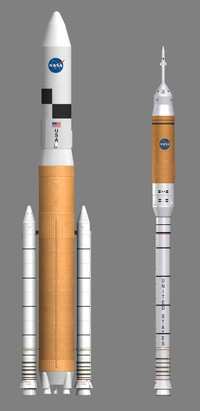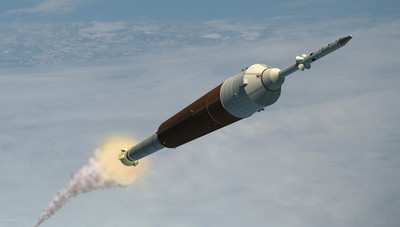Completes First Review Of NextGen Spacecraft
 NASA has completed a
milestone first review of all systems for the Orion spacecraft and
the Ares I and Ares V rockets. The review brings the agency a step
closer to launching the nation's next human space vehicle... and
answers questions about a possible shortage of available thrust
with the Ares I launch vehicle.
NASA has completed a
milestone first review of all systems for the Orion spacecraft and
the Ares I and Ares V rockets. The review brings the agency a step
closer to launching the nation's next human space vehicle... and
answers questions about a possible shortage of available thrust
with the Ares I launch vehicle.
NASA completed the thorough systems requirements review of the
Constellation Program this week. Review results provide the
foundation for design, development, construction and operation of
the rockets and spacecraft necessary to take explorers to Earth
orbit, the moon, and eventually to Mars.
"This review is a critical step in making the system a reality,"
said Constellation Program Manager Jeff Hanley of NASA's Johnson
Space Center, Houston. "I am proud of this dedicated and diligent
NASA-wide team. We have established the foundation for a safe and
strong transportation system and infrastructure. It is a historic
first step."
This is the first system requirements review NASA has completed
for a human spacecraft system since a review of the space shuttle's
development held in October 1972. The Constellation Program system
requirements are the product of 12 months of work by a NASA-wide
team.
The system requirements review is one in a series of reviews
that will occur before NASA and its contractors build the Orion
capsule, the Ares launch vehicles, and establish ground and mission
operations. The review guidelines narrow the scope and add detail
to the system design.
"We are confident these first requirements provide an
exceptional framework for the vehicle system," said Chris
Hardcastle, Constellation Program systems engineering and
integration manager at Johnson. "This team has done a significant
amount of analysis which will bear out as we continue with our
systems engineering approach and refine our requirements for the
next human space transportation system."
An example of the activity was a review and analysis that
confirmed the planned Ares I launch system has sufficient thrust to
put the Orion spacecraft in orbit -- contrary to earlier reports
that suggested Ares was down by as much as one metric ton of thrust
required to put Orion into orbit.
That's not true, says NASA. In fact, the agency says Ares I
thrust provides a 15 percent margin of performance in addition to
the energy needed to put the fully crewed and supplied Orion into
orbit for a lunar mission. Engineers established Orion's takeoff
weight for lunar missions at over 61,000 pounds.

Each Constellation project also is preparing for a narrower,
project-level systems review, according to the following
schedule:
- Orion crew exploration vehicle, February 2007
- Ground operations (launch support), February 2007
- Mission operations (mission support), March 2007
- Extravehicular activity (space suits), March 2007
Once the project-level reviews are complete, the Constellation
Program will hold another full review to reconcile the baseline
from this first review with any updates from the project reviews. A
lunar architecture systems review of equipment associated with
surface exploration and science activities on the moon is expected
in the spring of 2009.
 NTSB Final Report: Cozy Cub
NTSB Final Report: Cozy Cub ANN FAQ: Contributing To Aero-TV
ANN FAQ: Contributing To Aero-TV Classic Aero-TV: Seated On The Edge Of Forever -- A PPC's Bird's Eye View
Classic Aero-TV: Seated On The Edge Of Forever -- A PPC's Bird's Eye View ANN's Daily Aero-Linx (04.29.25)
ANN's Daily Aero-Linx (04.29.25) ANN's Daily Aero-Term (04.29.25): Execute Missed Approach
ANN's Daily Aero-Term (04.29.25): Execute Missed Approach




